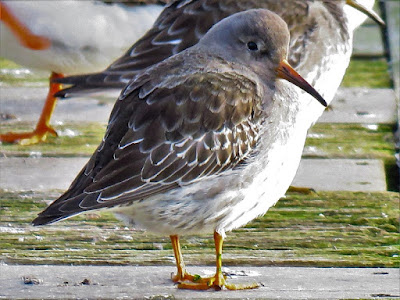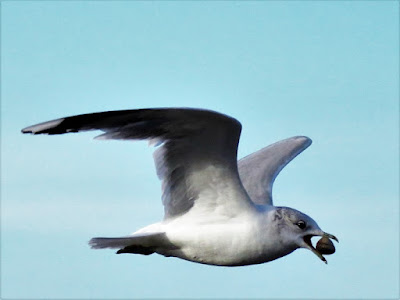Today I paid another visit to The Wirral, starting at New Brighton where a pontoon in the Marine Lake attracts birds to roost at high tide when their food is covered. The wanted species here was Purple Sandpiper.
Amazingly one of the first birds to arrive was a Purple Sandpiper, here with a Redshank for handy size comparison.The light was from an unhelpful angle but with a bit of photo editing the pale-based slightly decurved bill and yellow-orange legs (only one on view here!) on this rather tubby species can be seen.
Three Redshanks in different poses as they fly in. All the other birds are Turnstones apart from the far right-most bird which is a Purple Sandpiper.
Four (count the legs!) more Turnstones arrive. Purple Sandpipers are in the foreground at the left and right.
Two of the Purple Sandpipers, the right-hand bird with some vegetation on its right leg.
I think we can say 'job done'. It was time to move just down the road to look for Snow Buntings.
After much searching a Snow Bunting was spotted lurking in the dune grass.
Not easy to see but three here. Was I going to get a clear view?
Amazingly yes! They flew over my head to land on one of the fences placed to help stabilise the dunes. All five birds in the area lined up to have their photographs taken.
They showed little concern from three of us photographing them at close range though this shot is cropped and enlarged. We were all careful not to get too close.
Two of them.
One of the two shows its back.
Here one drops to the ground to look for seeds amongst the grass. Note the very black legs.
As this one does the splits it shows long black nails on those black legs.
Last one (for now): a profile shot. Another job done.
A Sanderling tucks in.
And two poking about.
Noisy groups of Oystercatchers passed by to roost as the tide came in. Note three birds at the left have a white band on the throat. These are first-winter birds.
On a lamp post an adult winter Common Gull.
One with food. Note that compared with a Herring Gull the bill is much thinner and pale green-yellow. The legs are also green-yellow.
Another with food.
Here two Common Gulls look to be pairing up. The bird at the back has its head thrown back and is emitting what is known as the 'long call' used by many species of gull. Its presumed partner is responding more demurely.
This shot shows that a Common Gull is much smaller than a Herring Gull. Here it is a first winter Herring Gull with its wings akimbo, showing the paler inner primaries.
Common Gulls may be dwarfed by Herring Gulls but they are much bigger than Sanderlings which are Starling-sized.
There was a report of a single Snow Bunting on the rocks by the Hoylake Lifeboat Station, just a few miles down the road. Without any pressure having had such great views earlier it was of course not too hard to find!
(Ed Wilson)


























